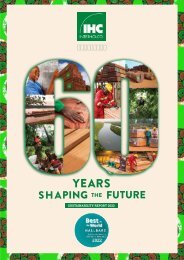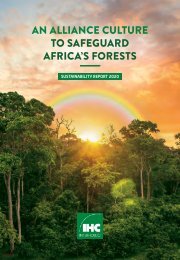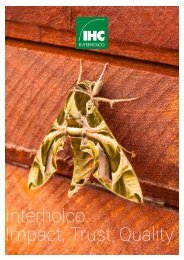Nomenclature Générale des Bois Tropicaux - 7ème édition
(english description below) Cette nomenclature est utilisée pour la mise à jour du 'Harmonized Code System' de l’Organisation Mondiale des Douanes. Dans la circulaire du 5 avril 2005, le Ministère de l’Economie, des Finances et de l’Industrie (France) reconnaît l’ATIBT comme « gardien du temple » de la nomenclature des bois tropicaux. La Commission Européenne mentionne la nomenclature de l’ATIBT comme document de référence pour la mise en œuvre du RBUE. Depuis 1954, l’ATIBT a établi et mis à jour une nomenclature des bois tropicaux faisant correspondre chaque espèce botanique avec un nom pilote reconnu internationalement. La détermination du nom pilote d’une essence est cruciale, car sa commercialisation dépend très largement de l’adoption de ce nom par le public. Le nom pilote assure la protection de l’appellation commerciale de l’essence et l’intégrité des propriétés qui lui sont attribuées, sans risque de confusion. The 1982 version of the general timber nomenclature has finally been updated as some of the 1,750 identified species, are no longer traded, while others, which were not previously included, are now on the market. The present revision has also integrated changes related to new taxonomy, in order to reflect the latest scientific developments. This Nomenclature has been used for the Harmonized Code System, updated by the World Customs Organization. The French Ministry of economy, finance and industry has given official recognition to ATIBT as the reference for the tropical timber nomenclature (NOR: PRMX0508285C of April 5th 2005). The European Commission refers to ATIBT nomenclature as a reference document for the implementation of the EUTR regulation. Since 1954, ATIBT has established and updated a nomenclature of tropical wood, linking each botanical species with an internationally recognized pilot name. A sigle wood species may have many common names; when trading across different countries, this may lead to confusion. Fixing the pilot name of a timber species is crucial, to protect the commercial denomination of the species and guarantee the veracity of the properties linked to that species, without confusion.
(english description below)
Cette nomenclature est utilisée pour la mise à jour du 'Harmonized Code System' de l’Organisation Mondiale des Douanes. Dans la circulaire du 5 avril 2005, le Ministère de l’Economie, des Finances et de l’Industrie (France) reconnaît l’ATIBT comme « gardien du temple » de la nomenclature des bois tropicaux. La Commission Européenne mentionne la nomenclature de l’ATIBT comme document de référence pour la mise en œuvre du RBUE.
Depuis 1954, l’ATIBT a établi et mis à jour une nomenclature des bois tropicaux faisant correspondre chaque espèce botanique avec un nom pilote reconnu internationalement. La détermination du nom pilote d’une essence est cruciale, car sa commercialisation dépend très largement de l’adoption de ce nom par le public. Le nom pilote assure la protection de l’appellation commerciale de l’essence et l’intégrité des propriétés qui lui sont attribuées, sans risque de confusion.
The 1982 version of the general timber nomenclature has finally been updated as some of the 1,750 identified species, are no longer traded, while others, which were not previously included, are now on the market. The present revision has also integrated changes related to new taxonomy, in order to reflect the latest scientific developments.
This Nomenclature has been used for the Harmonized Code System, updated by the World Customs Organization. The French Ministry of economy, finance and industry has given official recognition to ATIBT as the reference for the tropical timber nomenclature (NOR: PRMX0508285C of April 5th 2005). The European Commission refers to ATIBT nomenclature as a reference document for the implementation of the EUTR regulation.
Since 1954, ATIBT has established and updated a nomenclature of tropical wood, linking each botanical species with an internationally recognized pilot name. A sigle wood species may have many common names; when trading across different countries, this may lead to confusion. Fixing the pilot name of a timber species is crucial, to protect the commercial denomination of the species and guarantee the veracity of the properties linked to that species, without confusion.
Create successful ePaper yourself
Turn your PDF publications into a flip-book with our unique Google optimized e-Paper software.
Liste des noms pilotes des bois tropicaux avec renvoi aux noms scientifiques /// 63
PILOT NAME BOTANICAL NAMES COMMON NAMES
Garo Garo
Mastixiodendron pachyclados Melch.
Mastixiodendron smithii Merr. & L.M.
Perry
Garo Garo (PG)
Gavilán blanco Oreomunnea pterocarpa Oerst. * Campana (PA) ; Gavilán (CR) ; Gavilán blanco (CR)
Geronggang
Gerutu
Gheombi
Giam
Gintungan
Goiabao
Gombé
Gommier
Greenheart
Grenadillo
Grigri
Cratoxylum arborescens Blume
Cratoxylum glaucum Korth.
Cratoxylum p.p.
Parashorea densiflora Slooten & Symington
Parashorea lucida Kurz
Parashorea smythiesii Wyatt-Smith
Parashorea p.p.
Sindoropsis letestui J. Léonard
(Syn. Copaifera letestui)
Hopea ferrea Laness.
Hopea forbesii Slooten
Hopea helferi Brandis
Hopea nutans Ridl.
Hopea p.p.
Bischofia javanica Blume
Chrysophyllum lucentifolium Cronq.
Didelotia africana Baill.
Didelotia brevipaniculata J. Léonard
Didelotia idae Oldeman & al.
Didelotia letouzeyi Pellegr.
Didelotia spp.
Dacryodes excelsa Vahl
(Syn. Dacryodes hexandra)
Dacryodes occidentalis Cuatrec.
Dacryodes olivifera Cuatrec
Dacryodes peruviana H.J. Lam
Dacryodes p.p.
Chlorocardium rodiei Rohwer, H.G.
Richt. & Van der Werff
(Syn. Ocotea rodiei)
Dalbergia melanoxylon Guill. & Perr.
Licania canescens Benoist
Licania heteromorpha Benth.
Licania majuscula Sagot
Licania mollis Benth.
Licania rigida Benth.
Licania spp.
Geronggang (MY) ; Gerunggang (ID) ; Gonggang
(MY) ; Mapat (ID) ; Mulu (ID) ; Serungan (MY) ;
Sulunus (ID)
Cho-Chi (VN) ; Gerutu (MY) ; Gerutu Pasir (MY) ;
Khai Khieo (TH) ; Mai Hao (LA) ; Meranti Gerutu
(MY) ; White Meranti (ID) ; Meruyun (MY) ; Heavy
White Seraya (MY) ; Tavoy Wood (IN) ; Urat Mata
Batu (MY) ; Urat Mata Bukit (MY) ; Urat Mata Daun
Kechil (MY)
Gheombi (GA) ; Lumbandjii (CM) ; Ngom (GA)
Giam (MY) ; Takhian (TH) ; Thingan-Net (MM)
Gadog (ID) ; Gintungan (ID) ; Java Cedar (PG) ;
Nhoi (VN) ; Term (TH) ; Uriam (IN, PK)
Abiu Casca (BR) ; Abiurana (BR) ; Abiurana amarela
(BR) ; Abiurana goiaba (BR) ; Goiabao (BR)
Angok (GA) ; Bondu (LR) ; Broutou (CI) ;
Ekop-Gombé (CM) ; Gombé (CM) ; Timba (SL) ;
Toubaouaté (CI)
Anime (EC) ; Copal (EC) ; Gommier (MQ, GP) ;
Gommier blanc (MQ, GP) ; Gommier de montagne
(MQ, GP) ; Tabonuco (PR)
Beeberoe (SR) ; Bibiru (BR, GY) ; Demerara (GY) ;
Greenheart (GY) ; Groenhart (SR) ; Itauba branca
(BR) ; Sipiroe (SR) ; Viruviru (VE)
Chinsale (ZM) ; Dialambame (SN) ; Driedoring
(ZA) ; Ebbehout (ZA) ; Ebène (SN) ; Farakalay (ML) ;
Grenadillo (MZ) ; Kafundula (CD) ; Kasalusalu
(ZM) ; Kikwaju (KE) ; Mfwankomo (ZM) ; Mkelete
(ZM) ; Mkumudwe (ZM) ; Mokelete (ZA) ; Motangu
(UG) ; Mpingo (KE) ; Msalu (ZM) ; Mukelete (ZM) ;
Murwiti (ZW) ; Musonkomo (ZM) ; Pau preto
(MZ) ; Poyi (KE) ; Pulupulu (ZW) ; Sebrahout (ZA) ;
Swartdriedoring (ZA) ; Tabum (TD) ; Umbambangwe
(ZA) ; Zebe (ET) ; Zobbi (ET)
Anauerá (BR) ; Caraipé (BR) ; Carbonero (CO, PE,
VE) ; Grigri (GF) ; Kautaballi (GY) ; Konoko (GY) ;
Turiuva (BR) ; Zapote (CR, MX, PE)














